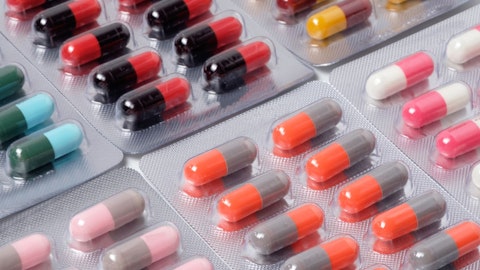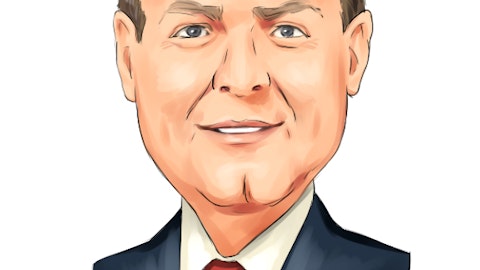I don’t think anyone’s got a penny of revenue in anybody’s model for any of these products. So as it sits today, they’re a bit of a drag on the equity story. So I just kind of wonder what the long-term strategy is? Is it to keep these, take them all the way through to development and marketing? Or at some point, do you think you’ll start out-licensing some of these products and tying up with people who might have more expertise in late-stage oncology drug development? I just wonder what this kind of big picture here is because at the moment, they’re all cost and no benefit from the equity markets perspective.
Victor Grifols Deu: Thank you, Tom. Yes, it’s a very, very good question from your side. Yes, clearly, Trimodulin and Fibrinogen will play a key role here as plasma will be in our core, both in the day-to-day in commercial and manufacturing, but also for our future developments. So plasma clearly will be on the core with those 2 products and the complement coming from our life cycle management that we are doing in different products. On those new technologies, for instance, on GigaGen, when we made the acquisition of this asset or this technology, I should say, was in line with our gamma globulin product portfolio. We saw that an interesting opportunity in the way we can obtain gamma globulin or specific gamma globulins from this technology.
It happened that, that company came also with this oncology interesting initiatives or programs there. And we just wanted to continue them. Going forward, if some of them are successful, we are clearly open to define and decide whether this remains in our core. And we, let’s say, expand to oncology or we kind of out-license whatever is the form for those, let’s say, non-plasma programs.
Nuria Pascual : Now Alvaro, also follow up.
Alvaro Lenze : Thanks for allowing me to jump back in the queue. Just 2 questions. First is on capacity and considering the fast growth in activity, if I am not mistaken, I believe, in Q2, you mentioned that you were around 60% capacity or something like that. If you could provide us an update on how is that trending? And when should you return to higher CapEx spending as CapEx is currently running lower than it has in the past? And the second question is just if you could provide some guidance on the evolution of minority like profits attributable to noncontrolling interests. They have been trending a little bit higher than I expected. There’s a little visibility as some of the companies here do not have a reported EBITDA like the collection — plasma collection networks of Haema and Biotest US. So whether we could extrapolate this €30 million per quarter like indefinitely? Or you could provide some guidance for this year and next year?
Alfredo Arroyo : Okay. I take both questions. Regarding capacity, yes, we confirmed in the last call, the 60% capacity for this year. And based on the upcoming sales growth and our projections, we expect that the next wave of CapEx expansion will take place in 2028, okay. So we have clear path of lower spend from now to 2028. Regarding the minority, the minority line within our P&L for your model, you can extrapolate €100 million per year
Nuria Pascual : Okay. Apparently, there were 2 persons who are trying to access and we’re having some kind of problems. We will try to give access from our side. We have Peter Verdult Citi. Can you hear us, Peter? No. Okay. We’ll try again later. And then Charles Pitman from Barclays. No? Okay. While we solve this, let’s continue with Thibault, you also had some follow-up. Can you hear us?
Thibault Boutherin : Can you hear me?
Nuria Pascual : Yes, we can.
Thibault Boutherin : So first question on the funding of the Alzheimer’s vaccine potential Phase III. Just wanted to know if you’re kind of open to out-licensing this or finding a partner to fund the R&D or if you’re willing to fund it yourself? And then second question, when we think about the underlying adjusted EBITDA this year, pro forma, including savings, the €1.75 billion, how comfortable are you with kind of consensus using this as a base going forward and using it as an underlying profitability guide for next year? Is there any kind of accounting elements or business elements we need to think about that would make it not a good approach to do that?
Victor Grifols Deu: I take that just part of a question about the Araclon vaccine. Yes, this was an important milestone for us that we have been waiting, the Phase II clinical trial and data out of that, as you have seen, very positive data across the board. The idea — and this is linked to a previous question, yes, we are very open to study potential out-licensing this product for the Phase III.
Nuria Pascual : And apologies, Thibault, but we could not hear you very well the second part of your question. Can you summarize it was on the accounting?
Thibault Boutherin : Of course, it was just — are you comfortable with kind of analysts and consensus using the €1.75 billion of underlying adjusted EBITDA margin that you are guiding, including all the pro forma savings? Are you comfortable with this being used as a base when we think about EBITDA next year, so basically including growth for next year? So basically, what consensus is, is basically using this number as a base for this year and going into next year. So I just want to understand if you’re comfortable with this approach?
Nuria Pascual : Thibault, we could hear you well this time.
Victor Grifols Deu: Thanks for repeating the question. Yes, we are comfortable with this €1,750 million considering these cash savings that they’re going to go into 2024. So therefore, yes, the — remember that out of the €450 million operating cash savings, $150 million roughly will flow through the P&L this year and $300 million next year. So that’s how we come up with this €1,750 million. So yes, we reaffirm that we’re confident.




